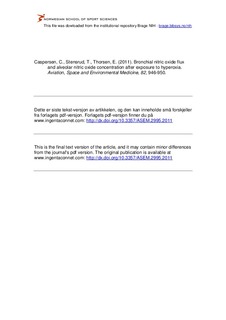| dc.contributor.author | Caspersen, Cecilie | |
| dc.contributor.author | Stensrud, Trine | |
| dc.contributor.author | Thorsen, Einar | |
| dc.date.accessioned | 2012-10-15T08:25:50Z | |
| dc.date.available | 2012-10-15T08:25:50Z | |
| dc.date.issued | 2011-10-01 | |
| dc.identifier | Seksjon for idrettsmedisinske fag / Department of sports medicine | |
| dc.identifier.citation | Aviation, Space, and Environmental Medicine. 2011, 82(10), 946-950 | no_NO |
| dc.identifier.issn | 0095-6562 | |
| dc.identifier.uri | http://hdl.handle.net/11250/171018 | |
| dc.description | I Brage finner du siste tekst-versjon av artikkelen, og den kan inneholde ubetydelige forskjeller fra forlagets pdf-versjon. Forlagets pdf-versjon finner du på www.ingentaconnet.com: http://dx.doi.org/10.3357/ASEM.2995.2011 / In Brage you'll find the final text version of the article, and it may contain insignificant differences from the journal's pdf version. The definitive version is available at www.ingentaconnet.com: http://dx.doi.org/10.3357/ASEM.2995.2011 | no_NO |
| dc.description.abstract | The fraction of nitric oxide in exhaled gas (FENO) is reduced by 30-70% after exposure to partial pressures of oxygen (Po2) of 200-240 kPa for 90 min. The purpose of this study was to partition FENO into its flow-independent alveolar and bronchial components. A reduced bronchial NO flux (JawNO) is associated with induced bronchoconstriction, while increased alveolar NO concentration (CANO) is associated with increased alveolar dead space. Methods: There were 12 patients undergoing hyperbaric oxygen (HBO) therapy for 90 min at a Po2 of 240 kPa and 20 healthy subjects exposed to normobaric hyperoxia (NBO) breathing 100% oxygen for 90 min who were compared to a control group of 6 subjects breathing ambient air. FENO was measured at flow rates from 30 to 250 ml · s−1 before and after the exposures and the Högman Märilainen algorithm was used to calculate JawNO and CANO. Results: FENO at an expiratory flow rate of 50 ml · s−1 was reduced from 17.6 ± 8.3 to 12.3 ± 6.3 ppb after HBO exposure and from 17.8 ± 6.2 to 13.3 ± 5.2 ppb after NBO exposure. There was a significant reduction in JawNO, but unchanged CANO. There were no changes in the control experiment. Discussion: The reduction in FENO after exposure to normobaric and hyperbaric hyperoxia appears to be predominantly an airway effect. An unchanged and low CANO indicate preserved integrity of the gas exchange units without increased alveolar dead space at rest. | no_NO |
| dc.language.iso | eng | no_NO |
| dc.publisher | Aerospace Medical Association | no_NO |
| dc.subject | diving | no_NO |
| dc.subject | hyperbaric oxygen therapy | no_NO |
| dc.subject | lung function | no_NO |
| dc.subject | oxygen toxicity | no_NO |
| dc.title | Bronchial nitric oxide flux and alveolar nitric oxide concentration after exposure to hyperoxia | no_NO |
| dc.type | Journal article | no_NO |
| dc.type | Peer reviewed | no_NO |
| dc.subject.nsi | VDP::Medical disciplines: 700 | no_NO |
| dc.source.pagenumber | 946-950 | no_NO |
| dc.source.volume | 82 | no_NO |
| dc.source.journal | Aviation, Space, and Environmental Medicine | no_NO |
| dc.source.issue | 10 | no_NO |
